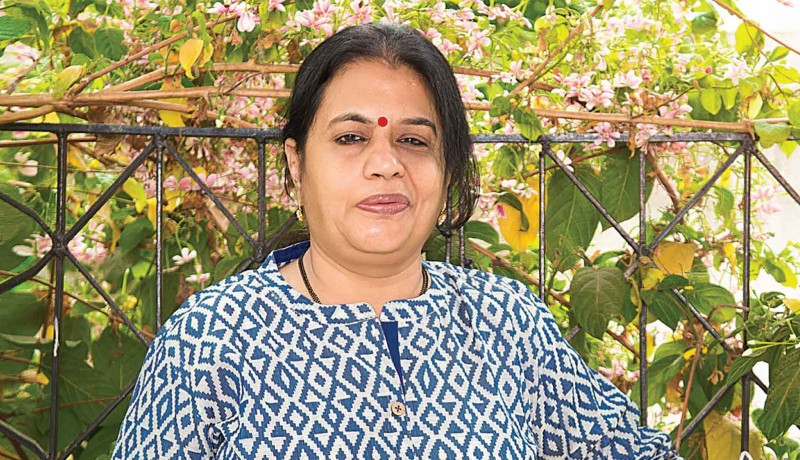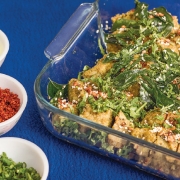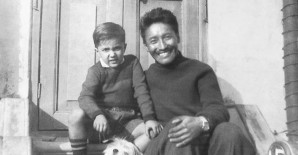
Columns

A series by Pratibha Jain about silvers who believe nurturing the body and mind is the key to joy.
Featuring Ajeeta Mehta from Chennai
What struck me when I stood in her kitchen was her sheer efficiency—it was neat and tidy, with well-planned cupboards stocking a wide range of ingredients. She deftly placed the jars of ingredients required for the recipe on a tray and proceeded to show me how to make a postnatal broth for my daughter, who had just delivered her firstborn. As she fried the edible resin granules and added the other spices, she kept giving me valuable tips. For instance, “Don’t forget to give her tender coconut every morning. Include carom seeds and pipramool [long pepper root] in her diet. And remember to order the shatavari powder [a wild asparagus believed to promote lactation and aid female reproductive health] for her.” When the broth was ready, she poured it into a thermos and placed it neatly in a cane basket for me to take to the hospital. Thoughtfully, she added a small jar of home-made mukhvaas (mouth freshener made with carom seeds, flaxseeds, dry coconut and
sesame) to the basket, saying, “Tell
her to chew this between meals.”
Does it sound as if we are old friends? And yet, I had met 57 year-old Ajeeta Mehta, a Gujarati Jain from Chennai, hardly a week ago. Our mutual friend Ashish Singhi insisted I meet her when my husband told him our daughter was expecting a baby. “She is just a street away and you will never find a more friendly and helpful person,” he said. And he was absolutely right. In the next few days, my daughter and I took many important decisions based on Ajeetaji’s advice, including the food routine during postnatal care. She also introduced us to the massage lady she had employed for her grandson, fixed the salary, and even appointed her on our behalf.
Some people are like that—angels in disguise! Over the next two months, I discovered that not only was she a walking encyclopaedia on pregnancy and postnatal care but traditional Gujarati cuisine and recipes with leftovers as well. Here are some snippets of my conversation with her.
IN HER OWN WORDS
I grew up in Mumbai amid my brothers and cousins; all in all, 18 boys. I was more of a tomboy, scared of nothing. I did not do much housework and never learnt sewing or cooking. But I could do anything the boys could. Even when I got married, my mother-in-law did not expect me to cook all by myself. So, unlike most other girls, I did not learn cooking from my mother or my mother-in-law. I started cooking on my own only when my husband and I shifted into our own house three years after my marriage. I coped very well. Such is life—our needs become our inspiration.
MY KITCHEN DISASTER
The first time my mother-in-law asked me to make kadhi, she gave me quite a large quantity of homemade buttermilk. I did not know how to prepare it. So instead of telling her, I started drinking the buttermilk [laughs]! But I did not feel nervous. I think when you grow up surrounded by brothers, it really makes you confident.
ATTITUDE TO COOKING
Knowledge is all around us. We have to be open to receiving it and applying the right thing at the right place. I have gained knowledge about pregnancy and postnatal foods through the people around me, books, and from my own experiences. Also, I like to know the health aspects of whatever I am cooking. I believe the more you know about these things, the more confident you become. For instance, in summer, one must soak mangoes as well as lychees in water for half an hour before consuming them. This reduces their heating quality so we can consume them easily.
KITCHEN TIPS
Nothing ever goes waste in my house. I try and use everything, including the peel and seeds of fruits and vegetables. For instance, do not discard the peels of carrots. Simply wash and boil them, and use as stock for soups. Use the peels of ridge gourd and cucumbers as well as bitter gourds to make chutneys. While rinsing vegetables, remove them from the top rather than draining the water. This ensures that the grit stays at the bottom.
A FAVOURITE RECIPE
Being summer, it is aamras [mango juice]. That too, only with pairi mangoes. For 5-6 pairi mangoes, I add one alphonso. Soak the mangoes in water and then make the juice. Just add sugar and a dash of dried ginger powder to balance their dosha. There cannot be a better aamras recipe than this.
USING LEFTOVERS
The idea of using leftover dishes is to be creative. I think real cooking cannot be learnt theoretically. One has to cook depending on ingredients, time and availability. So I make patties, parathas or muthia with leftovers depending on all these factors. But I can assure you of one thing—preparations with leftovers are as tasty as original preparations. However, we rarely have leftovers as I prefer cooking just enough for one meal.
HARMONY AT HOME
I always say I am on a 36-hour job [laughs]! Managing a house is not a joke. But if there is harmony at home, it becomes a wonderful experience. My husband Shailesh and son Ankit pitch in with the housework. My daughter-in-law Niketa shares a wonderful rapport with me. To me, these things are a blessing. And I am happy to give my 100 per cent to whatever I undertake. In 2005, I began catering from home. My clients gave me a very warm response over the years and that was my constant encouragement. I can say that I think with my heart and work with my brain. That combination works.
WHAT I TRULY CHERISH
The quality of relationships in life is more important than anything else—whether it is wealth or comforts. I lost my father when I was quite young but my brothers and cousins made up for the loss. Later when I got married, I found my in-laws to be truly rich emotionally. My father-in-law could never bear to see me sad even for a minute. My mother-in-law really took good care of me. I think it is because of her that I learnt to be a happy mother-in-law myself. And now, my grandson Hridaan makes my life magical with his innocent presence.
MUSMUSIYA
(Steamed nuggets with multigrain flour)
A traditional Gujarati recipe with cooked rice and multigrain flour, musmusiya is a much-loved dish in the Mehta household. It is ideal for the dry days of Ashtami and Chaturdashi when no fresh vegetables or greens are consumed. This multigrain flour can be stored and kept for months. It is highly nutritious and easily digestible. Ajeetaji uses it in many ways—for making parathas, white sauce and soups.
Ingredients
- Cooked rice (even leftover rice): 2 cups
- Multigrain flour*: 1 cup
- Kasoori methi: 2 tbsp
- Chilli powder: 1 tsp
- Coriander powder: 1 tbsp
- Turmeric powder: 1 pinch
- Asafoetida powder: 1 pinch
- Oil: 3 tbsp
- Salt to taste
Method
Mix all the ingredients gently without mashing the cooked rice. Set this mixture aside for an hour. (You can set aside for just half an hour or even 2-3 hours depending on your convenience). Roll the mixture into 3-inch rolls. Steam the rolls for 10 minutes by placing them in a perforated plate. Allow to cool. You can serve these rolls in a variety of ways. Simply sprinkle oil over the rolls and enjoy them. You can serve them with a sweet or spicy mango pickle. Traditionally, these rolls were served with a spicy mixture of salt, red chilli powder, coriander powder and asafoetida powder. To keep it healthy, simply serve them with plain yoghurt. And finally, as postnatal foods are a favourite topic between us right now, Ajeetaji recommends that these rolls are ideal for lactating mothers—to be served with ghee and sugar!
*To make the multigrain flour, grind 2 cups moong dal (with skin), 1 cup bajra, 1 cup rice, ¼ cup wheat and ¼ cup chana dal into a coarse powder (like chiroti rava). Ajeetaji prefers to grind this in the mill. If you are grinding at home, make sure the grains are sundried well.
Pratibha Jain, an author and translator from Chennai, is the co-author of two award-winning books Cooking at Home with Pedatha and Sukham Ayu. Her area of specialisation is documenting Indian traditions through research, translation and writing
Photos: D Kalaiarasan Featured in Harmony — Celebrate Age Magazine June 2017
you may also like to read
-
Mental workout
Mukul Sharma tells you how to keep those grey cells ticking Everyone will ultimately lose his or her brain….
-
Helpline
Dr Harshbir Rana answers your queries on personal and social issues related to ageing, elder care and intergenerational relationships ….
-
Off the cuff
Raju Mukherji pays tribute to his first hero, Tenzing Norgay, an exemplary mountaineer Darjeeling, 1955. Dr ‘Pahari’ Guha Mazumdar….
-
Yoga RX
Shameem Akthar shows ways to control debilitating ankle pain through regular practice Ankle pain is so common and prevalent….








